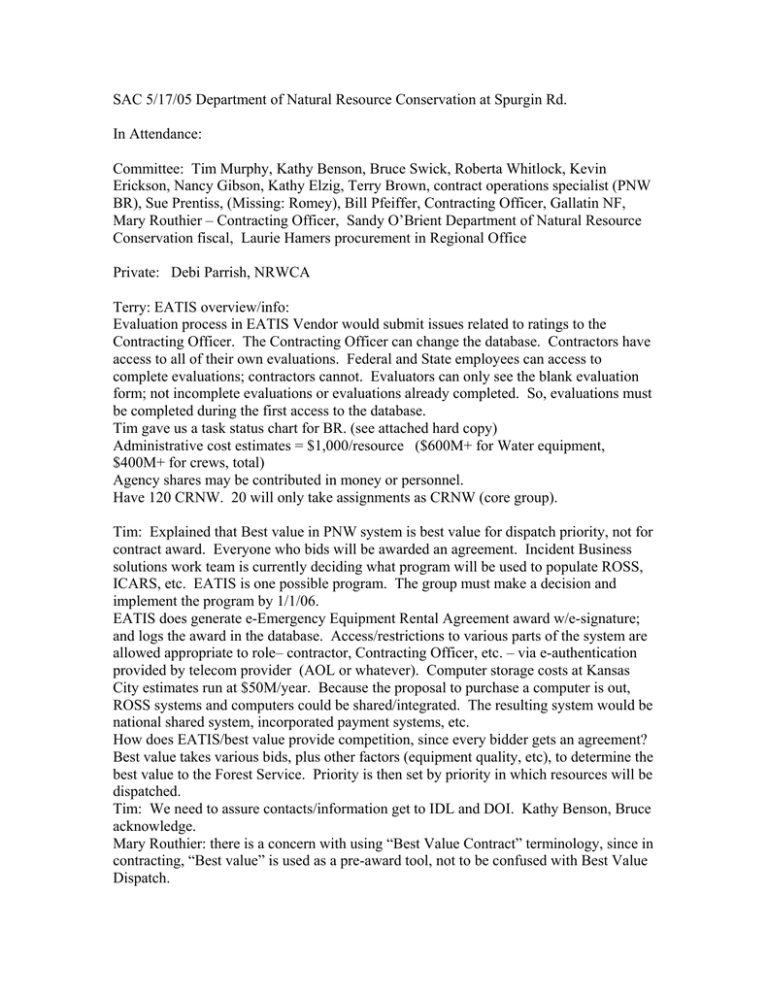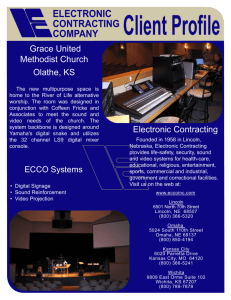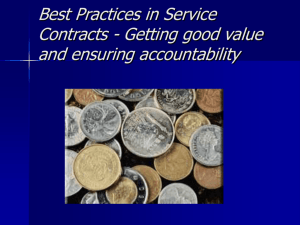SAC 5/17/05 Department of Natural Resource Conservation at Spurgin Rd.
advertisement

SAC 5/17/05 Department of Natural Resource Conservation at Spurgin Rd. In Attendance: Committee: Tim Murphy, Kathy Benson, Bruce Swick, Roberta Whitlock, Kevin Erickson, Nancy Gibson, Kathy Elzig, Terry Brown, contract operations specialist (PNW BR), Sue Prentiss, (Missing: Romey), Bill Pfeiffer, Contracting Officer, Gallatin NF, Mary Routhier – Contracting Officer, Sandy O’Brient Department of Natural Resource Conservation fiscal, Laurie Hamers procurement in Regional Office Private: Debi Parrish, NRWCA Terry: EATIS overview/info: Evaluation process in EATIS Vendor would submit issues related to ratings to the Contracting Officer. The Contracting Officer can change the database. Contractors have access to all of their own evaluations. Federal and State employees can access to complete evaluations; contractors cannot. Evaluators can only see the blank evaluation form; not incomplete evaluations or evaluations already completed. So, evaluations must be completed during the first access to the database. Tim gave us a task status chart for BR. (see attached hard copy) Administrative cost estimates = $1,000/resource ($600M+ for Water equipment, $400M+ for crews, total) Agency shares may be contributed in money or personnel. Have 120 CRNW. 20 will only take assignments as CRNW (core group). Tim: Explained that Best value in PNW system is best value for dispatch priority, not for contract award. Everyone who bids will be awarded an agreement. Incident Business solutions work team is currently deciding what program will be used to populate ROSS, ICARS, etc. EATIS is one possible program. The group must make a decision and implement the program by 1/1/06. EATIS does generate e-Emergency Equipment Rental Agreement award w/e-signature; and logs the award in the database. Access/restrictions to various parts of the system are allowed appropriate to role– contractor, Contracting Officer, etc. – via e-authentication provided by telecom provider (AOL or whatever). Computer storage costs at Kansas City estimates run at $50M/year. Because the proposal to purchase a computer is out, ROSS systems and computers could be shared/integrated. The resulting system would be national shared system, incorporated payment systems, etc. How does EATIS/best value provide competition, since every bidder gets an agreement? Best value takes various bids, plus other factors (equipment quality, etc), to determine the best value to the Forest Service. Priority is then set by priority in which resources will be dispatched. Tim: We need to assure contacts/information get to IDL and DOI. Kathy Benson, Bruce acknowledge. Mary Routhier: there is a concern with using “Best Value Contract” terminology, since in contracting, “Best value” is used as a pre-award tool, not to be confused with Best Value Dispatch. Tim confirmed: Montana State contacting Idaho Department of Lands and North Dakota State. Kathy Benson will be contacting Federal Contracting Officers; including Idaho Bureau of Land Management, DOI etc. Kevin Erickson will contact Federal fire agencies. Terry Brown– in EATIS program, Administrative role. Demonstrated screens, processes. Mary Routhier: Where is the solicitation? Is it on EATIS? Tim: negative- the solicitation is on Federal Business Operations, like usual. Kathy Benson: Can states link to federal business operations and EATIS also? Yes. Mary Routhier: How do vendors learn what to do? Terry Brown: Vendors will be issued a letter of instructions, plus PNW did training with vendors. When surveyed, 80% of vendors liked the system. *** add Mike Blinn and Starla Grill to attendance list *** Terry Brown: only the Contracting Officer can change or update data in database; Vendors cannot. Tim: Does ENGB have to be assigned to a specific piece or equipment, when CRWB is part of the criteria for determining best value? Negative – ENGB (CRWB?) has to be assigned to a company. (For a crew, CRWB’s and SQDB’s would be used for determining best value.) Tim: Can Emergency Equipment Rental Agreements issued by the states for Rural Fire Departments be managed by EATIS? Terry Brown: maybe, if they were entered in the system as a separate “solicitation”. Really don’t know until we try to do it. (Agencies pay some to equipment inspection contractors, and vendors pay most. Agency cost is included in administrative costs Terry Brown mentioned above. PNW also has contractor for qualifications inspections) We want to limit programming and local variations (i.e. CAF rates, etc.) Note: past performance will be factored in, beginning in ’06, to be based on past performance as documented during ’05, in EATIS. (EATIS generates a vendor e-mail list, which is very handy for sending info) Terry Brown did overviews of dispatch, performance evaluation, acquisition management, contracting officers, vendors, and inspection processes in EATIS. EATIS data entry: 4 seasonals x 4 months for Emergency Equipment Rental Agreements - copied from 2003 database into EATIS, then one clerk verified minimal info, Additional was needed time to correct typographical errors. Can our existing Emergency Equipment Rental Agreement database populate EATIS? Aqm (Acquisition management?) doesn’t have to enter data beyond solicitation, because vendors enter information with their bid. Dispatch has to enter data; information that is in ROSS for dispatch-related stuff. Vendor training takes about 4 hours/session. A workbook has been developed that they used at the vendor training. Starla: Forest Service Incident Business Solutions [team] has national IT and AQM support. Starla’s focus is on the business side of support to IMT’s and local units. Starla used some work by prior analysis/working groups, including national IT. She also used payment ctr/IBA perspective while looking for efficiencies. “Systems issues” were also looked at. The plan is to enter data one time, one place, and everyone in all agencies uses the same data. A contract database is a necessity, as is getting that information into ROSS. Tentative funding approval should be finalized this week. Terry, et al did presentation of EATIS to the IBS team. The team evaluated the program, tried to identify what will work, what will not, and how it can be used. I think I can say, that our team recommendation is, for 2006, to implement some form of EATIS, nationally, with some additions, modifications (i.e. additional types of equipment). We may eventually be able to integrate with IAS. Additionally, we may also be able to meet the data storage goal. There is currently plan beyond 2006. Because fire is interagency (among other differences), the team is working with the national IAS work group to adjust the program accordingly. IAS will not be required through 2006 for incident acquisitions. Will need to do “fitgap” with IAS before we can get final funding approval. This will probably happen within the next two weeks. National standardization will be critical to make it work, especially initially. National IT is contracting to have fields added to ROSS to integrate information. EATIS meets all the requirements of the OIG audit. Tim: Related to the white paper Kevin Erickson and Roberta were developing for presentation to the National Resource Coordinating Group: we need to continue forging ahead to get something into the National Resource Coordinating Group financial plan. We also need to try and address local costs, training, and time for building the database. Natural Resource Conservation Center (Kevin Erickson) can provide dispatch center information, and other basic information to get a head start. S: I can take Emergency Equipment Rental Agreement & contract data and put into a format to populate the EATIS database. Discussion about better describing the dispatch process not as “best value” dispatch, but more as how “best value” contract resources will fit into the process of assuring the most appropriate resource is dispatched and arrives at an incident. Tim: as we are inventing a new animal, the committee will be sunset for the summer, then reactivated in fall; hoping to have well-defined plan by November. DR will provide info to contracting/aqm at meeting [next month]? Message to contractors: business will go as usual for 2005. Changes and new process will not be determined until fall 2005. Debi says she is hearing many contractors are anticipating going out of business when best value is implemented. Kathy Benson and Bruce report out on contract clauses and evaluation criteria. They have established a committee to work on the following: operations, equipment, state, federal, Bureau of Land Management, and dispatch. We want to stay as close to the national template as possible. Skidgines will be the primary difference/addition. Strategic Action Committee 5/18/05 In attendance: Tim Murphy, DR, Nancy Gibson, Kevin Erickson, Marty Schmidt, Kathy Benson, Bill Pfeiffer (Gallatin NF CO), Bruce, Mike Blinn, Roberta, Kevin, Sandy O’Brient, (DNRC fire fiscal officer), John Monzie DNRC suppression supervisor. Private: Debi Parrish Tim: review agenda -- Brainstormed regarding fair share administration. -- Other loose ends including Kevin will research the National Wildfire Coordinating Group engine crew numbers requirements. Think Red Book; some federal agencies have 3 as the standard. The National Wildfire Coordinating Group standard still 2. Issue came up from Terry Brown yesterday related to PNW contracts. -- Roberta & Kevin Erickson will continue with developing the EATIS white paper for National Resource Coordinating Group, describing issues, need, etc. The funding request will be made pending a national funding decision (National IT, IBS team) Fair Share: Tim: the basic question is: How are we, in the National Resource Coordinating Group, going to make implementation of this new contracting system work? Who will administrate? Who will pay which portions of administrative costs? How will we “staff up?” Historically, inspectors and administration are not funded. Oregon State charges contractors administrative costs based on each assignment of contract crews. But federal agencies cannot do this. Maybe Montana State can do this within our interagency contract. However, when there are no fires (no assignments), there would be no money collected. In PNW, a Federal agency does engines, and pays administrative costs. Example of National Resource Coordinating Group funding Tim based on agency percentage of fires within geographical area. Bruce: Montana State could possibly charge contractors per use, but doing so would need legislative approval. Due to the timing of access, approval for anything involving FTE’s is doubtful to meet our needs (202006). We may be able to get approval from an interim committee. John Monzie: We might consider 1-2 primary positions (FTE’s) funded by Montana, which would give base funding over time and allow the program to function even in slow years. Base funding would be based on a formula of various agency use/fires. Then have a proprietary account to meet additional funding/work load needs. Money collected per use over and above base funding would be allocated into the proprietary account, possibly being available for use in reimbursement/relief to agencies. Is it an issue that Montana would be funding a program that utilizes resources in other States, possibly other countries? Base funding also provides continuity; consistency in programs via retention of staffs. DP: If best value contract is open nationally, numbers of contractors will increase incredibly. Group: will bids accepted be restricted by geographical area? We probably won’t be able to limit competition. Vendors nation-wide will be able to bid. Resources will have to meet response time. Currently, some vendors have Emergency Equipment Rental Agreements for a single piece of equipment in more than one zone. Maybe that best value contract will specify response time. But vendors may still be able to have agreements/contracts in multiple geographical areas. K: we will need to include strong language about consequences of turning down assignments due to inability to meet response time. Discussion about requirements to use national template for “contracts,” but not for “agreements.” PNW is doing a set number of formal contracts as well as agreements. Using contracts versus. agreements will allow us to use resources for work in addition to suppression (prescription etc.). Emergency Equipment Rental Agreements can only be used for suppression. Discussion about whether EATIS will be used to issue “contracts” or “agreements;” and how the contracts will be distributed across the geographical area. Kathy Benson, Bruce’s working group for clauses and evaluation criteria: Ann Voght (Bureau of Land Management equip), Chuck Stanich Forest Service Fire Management Officer/operations, Bruce, Kevin Erickson, Mary Clark (Bureau of Land Management business), will seek participation from Idaho Department of Lands and Montana. (Nancy: yesterday’s notes to reflect that nationally, EATIS being considered for use for possibly 2 years, maybe permanently.) Agreement that first contracts will be for single year. Eventually, we may be able to do multi-year contracts. Fair share costs related to inspections: K: when will inspections be done? Inspections will be performed before award, but in May, February? Inspection/administrative costs will vary depending on timing. Contracts for 2007 may be able to be timed to enable prescription use, but 2006 will not be possible. Kathy Benson wants to decide whether 2006 contracts should include project and severity line items. Would those line items’ rates be based on a percentage of the suppression rate? Various rates exist for different work: ex. Stand-by parked versus. patrol and extinguishing campfires, etc. Roberta: the national template does address various types of work. Tim confirms: the goal for water is that by 2006, we will have something set up, based on the national template with suppression, project, and severity/standby. Inspection forms will be modified to meet new requirements, and then inspections will be completed in time to enable equipment to be available for spring work. We will continue to follow task timelines. Kathy Benson will mail a draft to the Strategic Action Committee and agencies involved for review in September. In October, it will then be mailed to contractors and the National Resource Coordinating Group for review. In November, we will address comments and have final draft for the December 7 meeting. A contract will hopefully be on the street in January 2006. Tim: from yesterday’s National Resource Coordinating Group BOD meeting: National Resource Coordinating Group will revise policy statement to define “government” as federal, state and local government as priority, then contractor. Kathy Benson: all contracts have language saying we always reserve the right to use government resources first. Tim: The Blackfeet Tribe is pursuing contract tribal crews, as a corporation. They have existing MOU’s and are doing all training internally (versus. via Bureau of Indian Affairs). They are also beginning to consider engine contracts. Roles, etc. need to be clarified. Some tribes are sovereign, some are incorporated; resulting in a multitude of questions. Bruce will consult with his boss while Marci and John are to get a decision on possible base funding. Sandy O’Brient: was John M: base FTE’s would probably need to be Contracting Officer’s Representatives at least, sees them as National Resource Coordinating Group positions that set standards, administer contracts, have oversight of hiring, supervise additional staff, and oversee spending of proprietary account money. They also need to be able to deal with claims, especially initially. National Resource Coordinating Group-level organization and program development and administration needs to happen similar to how timber contract administration was developed. These people would also have oversight and assist Contracting Officer’s Technical Representatives, inspectors, etc. at incidents. As National Resource Coordinating Group employees, someone (State?) would carry the FTE’s. John also feels it would be good to have them attend Federal Contracting Officer’s Representative training. Contracting Officer’s Representative base/oversight would cover Contracting Officer’s Technical Representative/inspectors who could “specialize” in different types of contracts (crews, equip, etc). The program could include a possible career path. Kathy Benson and Bruce’s group will work on developing a proposal for fair share cost distribution for non-incident administrative programs. The base program would be funded. In the long term, additional funding sources, such as per-use charge to contractors, will be considered. The users would pay for use of contracted resources other than fire (such as: project work task order). User/local units would need to provide contract administration (Contracting Officer’s Representative, for example)– we will have a proposal by September. Roberta is working on incident/suppression administration assistance with evaluations, performance issues, etc. Marty is representing the contracting perspective to explain to the National Resource Coordinating Group funding to support the fire-related workload. Kathy Benson: Sue Prentice is supporting fire-specific aqm/contract position, rather than “everyone” doing the contracting work. Maybe administration support funding organization needs to be staffed federal out at that level. John: National Resource Coordinating Group cost distribution won’t be hard to figure out. Roberta: and remember we may have additional contracts; inspections of equipment and qualifications. Kathy Benson: might want to consider distributing contracts by agency – that would be one way to share costs fairly, according to what each agency’s capabilities and use are (spending limitations, admin staffing, other authorities, etc.). Mary Routhier: contracting wants to find ways to support fire more efficiently. Current pre-season Emergency Equipment Rental Agreement processes are inefficient and costly. Tim: Contracting Officer’s Technical Representative pool – Readers Digest Version Roberta explained the National Wildfire Coordinating Group task group’s (as part of IBMP working team) proposal regarding contract administration support at an incident for line resource contracts (caterers, showers, etc. remain the same, in logs). Additional specialized Contracting Officer’s Technical Representative for operations resources are needed. The proposal basically consists of a specialized Contracting Officer’s Technical Representative position, plus establishing a Contract Administrative Unit Leader. The Contracting Officer’s Technical Representative ties in with the division supervisors and other line supervisors to help with problems, facilitate evaluations, documentation, liaison with Contracting Officers, Plans, and Finance. See attached hard copy proposals. The Task Group has developed pd’s, PTB’s, flow charts of ICS structure, and recommendations for team membership. Timing and opportunities for having these recommendations considered by the IOS WT, or 310-1 changes appear limited/minimal. So… In this geographical area, Roberta, Kevin, and Tim are suggesting to add to the training of equipment inspectors to include contract familiarity, limits of authority, roles, lines of contact, etc., so they can assist at an incident in Contracting Officer’s Technical Representative-type functions. We want to identify a pool of maybe 10 core people who will/can commit to accepting assignments in a given geographical area. We will make a proposal to National Resource Coordinating Group to do pilot of using the PTB’s etc. If it works well, IOS WT will be presented with info, proposals, via National Resource Coordinating Group representative (Shiplett). Fire needs administration on contract stuff; there is basically none at this point. The current situation is contrary to all contract administration direction and policy. Discussion was then about ordering/use of Contracting Officer’s Technical Representatives at a given incident. Standard practice is of ordering/filling the positions with dispatch/establishment of a team. Identified core group– it would be good to develop Contracting Officer’s Representative knowledge and skills for future. This knowledge and these skills would be beneficial for all agencies’ people to have (mostly federal/state). Basically, Contracting Officer’s Technical Representatives need to be able to meet interagency needs, just as with other ICS positions. We need to be able to truly take an interagency approach to developing the program and these positions/people for consistency as well as effectiveness. Eventually, this program will reduce the workload of local Contracting Officers, though initially, it requires additional time commitment of local Contracting Officers. Kevin will review the interagency list of inspectors and will list possible contacts to find interested/available people. We will attempt to do training before fire season, so they can be utilized this year. Dispatch tasks/organization What zones will we have, and how will dispatch work for best value contracts? Currently, there exist 14 dispatch centers. Will the zones be different depending on whether need is within the geographical area or outside? In the geographical area, for local use, centers would utilize local resources/neighborhood resources. Outside a geographical area, resources might be dispatched from the geographical area level. These contract resources might, overall, be dispatched from different zones. Each zone has different expectations and needs. We need to get picture of what each zone needs in order to describe response times. We need to discuss Initial Attack versus extended attack, and out-of-area assignments. To do this, we need input from operations people. We may need to exclude Initial Attack from the contract. We also need to assure discretionary authority is maintained within contract, dispatch and utilization processes. Kathy Benson: Marty Schmidt will be able to commit to consistent participation on the Strategic Action Committee. Tim says it would be good to find a Montana Department of Natural Resource Conservation fire-type person to participate on the Strategic Action Committee. MEEETINGS: June 7: conference call @ 1000. Sept 19-21: 1000 -1500 Oct 17-18 (bus comm. On 19th): 1000 - 1500 Nov 15-17: 1000 - 1500 (Dec 7: NRWCA) Dec 13-15 Lunch 1140 – 1300 Bruce & Kevin: Update on Contracting Officer’s Technical Representative core group training: June 8-9, tentatively for Contracting Officer’s Technical Representative training in Missoula Kathy Benson; suggested add S-261 as required training for Contracting Officer’s Technical Representative. Training Update: Evaluation form – we have agreed to use S244, as developed by PNW, and in EATIS. Nancy will tie in w/Romey to determine and implement distribution. Modifications will be made to instruct that completed forms be sent to Natural Resource Conservation Center. Business Update: Bruce & Kathy Benson Discussion happened revolving around the National engine contract template and how it will work with our planned interagency system. Bruce: Montana Association of Counties. Local governments (Rural Fire Departments), can they bid on contracts awarded by Federal/State? Montana Association of Counties agrees there is no law prohibiting them from bidding. If rural resources were prohibited from participating in paid-for firefighting, it could negatively impact their local capabilities (loss of funds). Roberta: request clarification on task of consequences of negative behavior/poor performance. It was agreed this would be addressed in contract. There is no need for other additional actions. Task complete/canceled. **** update timeline to reflect completion/changes/cancellations to tasks. Equip – Kevin Preferred inspection would be by traveling team(s), rather than various inspectors from individual units. For consistency’s sake, standardization is essential; especially when we go to one geographical area contract. Ideally, there would be a core group at least partly funded to complete inspections. This core group could be supplemented with additional inspectors, and to do re-inspections, etc. If agency people are not funded, inspection would need to be contracted, and that cost will have to be covered somehow. Kathy Benson: re-inspection fees might be able to be deducted from first payment. Kevin will pull together rough cost estimates. Some training will have to be accomplished to make our current inspections fit into the EATIS (inspection) evaluation system/criteria.







